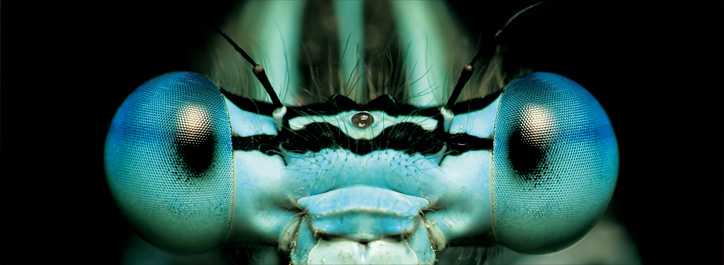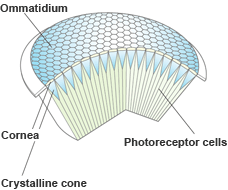
The damselfly’s protruding compound eyes give it a wide view.
There are more than 1 million species of insects, which some researchers believe account for more than 70 percent of all the known animals living on the Earth. The U.S. National Entomological Collection at the Smithsonian Museum of Natural History in Washington, D.C., contains approximately 35 million specimens of 300,000 species. The Natural History Museum in London has a collection of approximately 28 million specimens — and a staff of about 100 to care for them. Indeed, we can see insects everywhere. But what do they see?
Out of Many Eyes, One Eye
The word “insect” comes from the Latin insectum, which means “cut into sections.” All insects have a head, thorax (midsection) and abdomen, three pairs of legs, a pair of antennae, and compound eyes. The eyes are a true expression of teamwork, an intricate system of visual receptors called ommatidia. Every ommatidium — there may be just a few or up to 50,000 in a pair of compound eyes — features a lens, a clear crystalline cone, photoreceptor cells, and pigment cells that separate it from other ommatidia.
Insects are small but have large body surface areas. Dr. Ryohei Kanzaki, a professor of Intelligent Cooperative Systems at the University of Tokyo’s Research Center for Advanced Science and Technology, explains that this enables them to have many sense organs on their outer bodies, including compound eyes. The reason behind this is simple math: Area increases or decreases to the second power of the length while volume increases or decreases to the third power.
Insects have compound eyes because they are too small to be single-lens creatures. Dr. Kanzaki says focal length is the key factor. “If insects had the same eyesight as humans, the focal length would end behind their heads. Their size mandates that they have compound eyes.”
Each ommatidium contributes information about a very narrow angle of the field. Together, all the ommatidia create a mosaic image; how “sharp” that image is depends on how many ommatidia there are. This structure allows insects to detect motion very effectively, a “flicker effect” in which the ommatidia are progressively turned on and off as an object crosses the insect’s field of vision.
Dr. Kanzaki says, “You would think that compound eyes would give insects better eyesight than humans. But an insect’s eye has only 1/100 of the resolving power of the human eye.” He does point out, however, that insects manage quite well by enhancing their vision and angle of view with their compound eyes: “With these eyes, they fly, detect targets and escape danger.”
 In the Precambrian era (around 570 million years ago), deuterostomes were distinguished by their embryonic development. In deuterostomes, the first opening (the blastopore) becomes the anus, while in protostomes it becomes the mouth. Humans (vertebrates) are at the end of one branch of evolution and insects (arthropods) are the latest offspring of the other branch.
In the Precambrian era (around 570 million years ago), deuterostomes were distinguished by their embryonic development. In deuterostomes, the first opening (the blastopore) becomes the anus, while in protostomes it becomes the mouth. Humans (vertebrates) are at the end of one branch of evolution and insects (arthropods) are the latest offspring of the other branch.
(Reference: Courtesy of Dr. Ryohei Kanzaki)
Compound Eyes Prevent “Brain Overload”
An insect’s brain has a few hundred thousand neurons; a human brain contains 100 billion. Still, insects experience the world through the same five senses and respond to environmental changes much as we do — by using smell, sound, taste, light and air pressure. Processing that much information in a brain with such small capacity would hamper insects’ quick response to their environment. As highly sophisticated receptors, compound eyes help insects maintain their responsiveness, crucial for survival in nature, by sending only selected information to the brain to prevent it from overloading, Dr. Kanzaki says.
 A compound eye consists of a collection of hexagonal ommatidia. Each ommatidium features a thin lens, which only accepts light from a narrow angle. A multitude of ommatidia arrayed in ranks forms the compound eye, enabling a much wider view.
A compound eye consists of a collection of hexagonal ommatidia. Each ommatidium features a thin lens, which only accepts light from a narrow angle. A multitude of ommatidia arrayed in ranks forms the compound eye, enabling a much wider view.
Honeybees, for instance, have compound eyes that can see ultraviolet light, allowing them to easily detect nectar and pollen at the center of flowers. In brassica flowers, for example, the pollen absorbs ultraviolet light and appears black to the honeybees.
The upper parts of honeybees’ compound eyes are equipped with a function similar to a polarizing plate, which changes the degree of brightness of the light passing through depending on its incoming angle. This allows them to precisely detect the position of the sun by the degree of brightness of the light in order to navigate themselves.
Another amazing insect is the dragonfly, some species of which have more than 50,000 ommatidia in their pair of compound eyes. “One ommatidium comprises about 10 cells,” Dr. Kanzaki explains. “A dragonfly possesses about 500,000 vision-sensing cells — almost as many neurons as in its brain. This illustrates how much of a dragonfly’s brain capacity is devoted to vision.”
The large capacity of their compound eyes allows dragonflies to see the world clearly, flee predators and hunt their prey. It is this type of adaptation that Dr. Kanzaki says has enabled dragonflies — and all insects — to survive and flourish over about 300 million years.
“Quick response is more crucial than anything else for insects to survive. Besides their compound eyes, insects’ information-processing systems evolved with many amazing features to prioritize such responsiveness,” states Dr. Kanzaki, a leading scholar of the technological application of the brain mechanisms of insects. “Applying such features, various new sensors and robots that utilize unprecedented technologies have been developed.
- 1. Insects: Eyes that See the World in a Different Way
- 2. Our “Super Vision” into the Universe
- 3. The K computer: A New Way of Looking at the World

